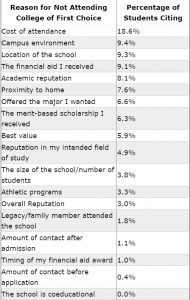Does your school board allow your admissions team to offer sales or applicant incentives?
Let’s start by addressing the elephant in the room – school tuition confirmation. Approximately 90% of school boards establish the following year’s tuition sometime between December and February of each year. But for those on an international admissions cycle, this timeline is too late into the recruitment season and frustrates international clientele.
Imagine your school as a product with no price tag able to be shared until Feb-March of that year. Would you buy it, not knowing what the final price will be? This is a hard sell for even the best of the best of salespeople.
It’s understood that tuition for the next fall is not typically at the top of the to-do list at the beginning of the academic year (Aug-Sept). However, as the international market matures, wire transactions have become stricter with more limitations, and natural parents are becoming more budget-conscious of their investments – tuition information and confirmation becomes increasingly more important as a deciding factor for potential students. Earlier confirmations of school tuition grant a competitive edge so that schools will have stronger traction in promotions and more confidence throughout the market. To see our complete checklist for preparing for international student recruitment in 2020, click here.
Budgeting is more critical for families than it is for schools. As the middle class in China and other countries like Vietnam continue to grow, families become more price-sensitive as well as knowledgeable about the education market. For the secondary education industry to remain stable and trust US education institutions, schools and service providers must control fee inflations to maintain customer confidence.
According to a 2017 study by Royall & Co, the study showed that the top deterring factor for students to not enroll at an institution was, in fact, the cost of attendance or tuition. Prospective international students at both the secondary and higher education level receive a multitude of offers each year and then must narrow down the opinions to their final choice. The cost of attendance was cited as the main reason for about one-fifth of students deciding against going to their top choice of school. While many other students who also opted not to go to their favorite school said, they made the decision based on other cost-related reasons such as financial aid, non-need-based scholarships, and school’s value. When all of the cost-related factors are added total, they account for a staggering 39.9% of why students chose not to attend their top school choice. (see table 1)

Below are the top four strategies for strengthening your school’s international student admissions and retention efforts. Especially for programs which heavily rely on recruitment channels from East Asia, we strongly recommend the following:
Tuition Freeze
Universities are currently leading this incentive plan that will soon be followed by private secondary institutions. Schools like the University of Vermont and the State of New Jersey are deciding to freeze tuition for students for future financial stability and sustainability of the market. Universities like UVM are turning to alternative sources income like “growing non-traditional enrollments, using its campus more in the summer, accepting more transfer students, increasing student retention, and tapping its donor base.”
Tuition Caps
Whether by dollar value or overall percentage, an offer or promise to not increase tuition year-over-year by a set amount would give many families ease of mind and the ability to start planning their finances for the following year.
Scholarships
Establish a scholarship program for your international students. This will show your current and potential families that you value your international student program and, indeed, are mission-driven. Any student – be that domestic or international – thrive for merit-based scholarship opportunities big or small, so a little could go a long way.
$1,000 Early Bird “Deposit” Discount
As one of the most straightforward incentives to increase application volume, try offering $1,000-3,000 “early bird” discounts based by region for the first five students placing a deposit at your school to promote early deposits and enrollments in the season.
Free Applications
With all the above requiring school board buy-in but also some serious budgetary planning nearly a year in advance, start small by offering free applications or interviews for a short period. This will typically happen at the end of the season (Mar-Apr), however, there’s a trend where it’s offered earlier in the season (Nov – Jan 31) and combined with the “Early Bird Deposit Discount” highlighted above.
With ease comes risk, so officials need to pay close attention to their conversion rate from interview-to-deposit with this recruitment strategy. Students have been known to abuse this system using this incentive as a free “interview practice” for admittance into their dream school. If not carefully monitored, schools can interview over 25 students, while only enrolling one or two.
Read more international student recruitment here.
For consultation and advice about your international student program needs, please reach out to your Program Manager (PM) or [email protected].
Visit our blog section to learn about industry trends, international program best practices, ways to engage students, and more.
For schools looking for more information on Cambridge Network and our services, please submit an inquiry form.
